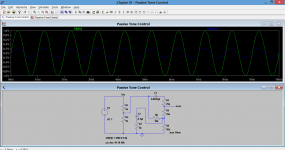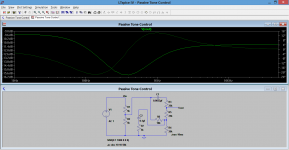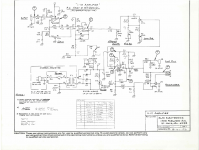Please post the full schematic so it makes sense.
Split in small unconnected pieces it's easy to skip errors or make wrong assumptions.
Split in small unconnected pieces it's easy to skip errors or make wrong assumptions.
In this case I think a gain stage after the tone stage but I wonder whether you have a construction error because it shouldn't be killing the output completely. You can see here the controls centred and the relative levels of Vin and Vout. So if its really as quiet as you say then something is wrong.
Is the stage its working into of sufficiently high impedance ? That's the 220k in your opamp circuit... that's OK. If your connecting the tone stage to the TA2020 then you need to know its input impedance. If its lowish then that will pull the voltage down a lot more.
Is the stage its working into of sufficiently high impedance ? That's the 220k in your opamp circuit... that's OK. If your connecting the tone stage to the TA2020 then you need to know its input impedance. If its lowish then that will pull the voltage down a lot more.
Attachments
@Mooly, the output is going into a line-level input on the TA2020 amp. I'll check the circuit again for errors. It is good to know that the circuit itself should work as expected.
@JMFahey, apologies, I've attached the full circuit in this post. The only differences are that I'm using a wall-wart for the power, and a Lepai TA2020 clone for the power amp stage.
@JMFahey, apologies, I've attached the full circuit in this post. The only differences are that I'm using a wall-wart for the power, and a Lepai TA2020 clone for the power amp stage.
Attachments
You need to know the TA2020 input impedance. Unless it matches this circuit then not only will the levels be different but also the frequency response. It all works together as one.
This power amp stage uses both voltage and current feedback but the headline news is the 1k5 and 10 ohm feedback network giving a voltage gain of around 150. The TA2020 will probably be nearer 15 to 20 at a guess.
So I would recommend an opamp stage after your tone stage, and one that matches the impedance here. It also needs to have a fairly high voltage gain of perhaps around 8 to 10.
This power amp stage uses both voltage and current feedback but the headline news is the 1k5 and 10 ohm feedback network giving a voltage gain of around 150. The TA2020 will probably be nearer 15 to 20 at a guess.
So I would recommend an opamp stage after your tone stage, and one that matches the impedance here. It also needs to have a fairly high voltage gain of perhaps around 8 to 10.
Is there a way to find out input impedance? I don't know anything about how to design an opamp stage to match a certain impedance, I'd appreciate if you could give me a couple of pointers to stuff I should read up on.
Thanks!
Thanks!
To find the input impedance on an unknown circuit is fairly easy.
1/ Apply a lowish frequency test tone as an input signal (say in the 100Hz to 400Hz range so that any DVM on AC volts can read it).
2/ Set the volume of the amp to give say 1.0 volts AC across the speaker (or a dummy load so things stay quiet).
3/ Now add a series variable resistor to the input feed (just using the centre and one end lead on a preset or pot of say 470k value)
4/ Adjust the preset to give 0.5 volts across the load.
The value of the series resistance will equal your input impedance.
An good opamp will drive loads of 600 ohms and higher. That means that if you connect a 600 ohm from output to ground then the opamp output voltage is unaffected.
Your circuit above shows the tone stage working into a load of 100k (R17) although the effect of C14 will make that apparent value rise as frequency falls.
I can't really think of any specific reading material for this beyond basic opamp theory and general electronic theory. For most cases we have a low output impedance feeding into a high. In other words we make sure that whatever we hang on the end of a circuit as a load does not influence the circuit before.
Your tone stage is the "exception" because for it to perform as intended, it must see the impedance the designer intended (the impedance the unmarked P3 pot sees. And that is the following opamp stage).
1/ Apply a lowish frequency test tone as an input signal (say in the 100Hz to 400Hz range so that any DVM on AC volts can read it).
2/ Set the volume of the amp to give say 1.0 volts AC across the speaker (or a dummy load so things stay quiet).
3/ Now add a series variable resistor to the input feed (just using the centre and one end lead on a preset or pot of say 470k value)
4/ Adjust the preset to give 0.5 volts across the load.
The value of the series resistance will equal your input impedance.
An good opamp will drive loads of 600 ohms and higher. That means that if you connect a 600 ohm from output to ground then the opamp output voltage is unaffected.
Your circuit above shows the tone stage working into a load of 100k (R17) although the effect of C14 will make that apparent value rise as frequency falls.
I can't really think of any specific reading material for this beyond basic opamp theory and general electronic theory. For most cases we have a low output impedance feeding into a high. In other words we make sure that whatever we hang on the end of a circuit as a load does not influence the circuit before.
Your tone stage is the "exception" because for it to perform as intended, it must see the impedance the designer intended (the impedance the unmarked P3 pot sees. And that is the following opamp stage).
Hi,
I'm trying to build a small practice bass guitar amp. The main goal is to have something easily portable that can be carried around when jamming at someone's house, for example. My idea is to use a basic class D (like the Lepai 2020) for the main amplifier, and build a simple solid-state preamp. House the whole thing in a ported box with a 6-inch woofer.
Is this a reasonable goal?
I'm looking for suggestions for circuits I could use for the preamp stage.
Also, most 6-inch woofers I've seen seem to have a freq response of 50Hz at the low end. Given that a bass can go below that, how does that impact port tuning?
Thanks.
I've wanted to do one these myself. I found this online and looks like it would be a good feed for the amp. You could even battery power it if you wanted to. Read the thread, there are some changes.. You could even sub a baxandall instead of that fender tone stack, if ampeg is your flavor.
FET-2B Bass Preamp, my first "design"
As far as the speaker.. well, it's hard to beat square inches for good bass volume.. I'd go 10 or 12 there. I'm sure something cheap could be found if it's a budget build.
That's a very interesting design, thanks for sharing. There's a lot of useful info in that thread, including a link to another JFET-based design: Bass Preamp
I'm with JMFahey in upping the speaker size. The smallest rig I've actually rehearsed or played out with is 40w into a single 10" w/tweeter. Bass guitar speakers are actually mid-bass drivers, not woofers(!). Since all bass guitars using magnetic pickups (not optical or piezo) output more second harmonic than fundamental, that works.
An excellent and reasonably priced 10" bass guitar driver is the Faital 10FE200.
An excellent and reasonably priced 10" bass guitar driver is the Faital 10FE200.
Last edited:
- Status
- Not open for further replies.
- Home
- Live Sound
- Instruments and Amps
- *small* Bass guitar amplifier


